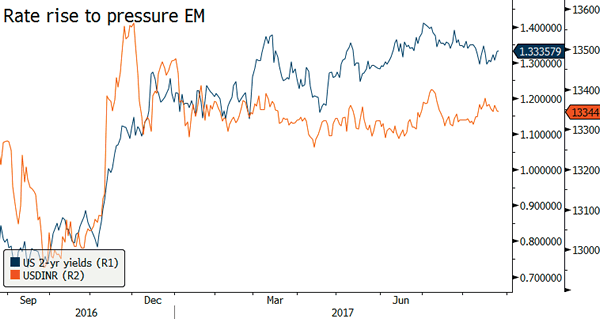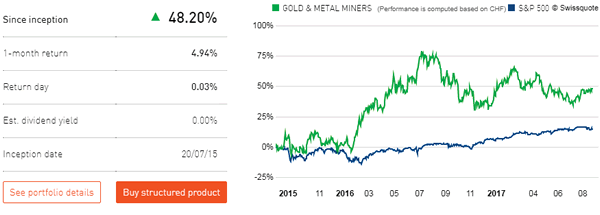- Time To Deleverage Carry Trades – Peter Rosenstreich
- NZD: Local Developments Don’t Matter – Arnaud Masset
- Switzerland: CHF In Depreciation Mode – Yann Quelenn
- Gold & Metal Miners
FX Market – Time To Deleverage Carry Trades
We have been a massive advocates for the EM carry trade strategy over the last 12 months. However conditions have moved forward, and price actions indicate, that its time to step-off the pedal slightly (although not completely). Friday’s Wyoming speeches from Yellen’s and Draghi have preoccupied the market sentiment proving a justification for EM stagnation. Hence many are calling for a risk rally when neither central banker introduces new information on monetary policy. Yet, the fact remains the Fed and ECB are moving toward tightening. Government bond yield basically risen since April with each pullback getting smaller and quicker. The rational is simple.
First, geopolitical risk have increased in our view. Despite our overarching rule to discount, Trump generated hype, each event, which passes without incident increases the likelihood that the next time will be a actually crisis. North Korea, NAFTA, US debt-ceiling all are teetering on the edge with limited hope of a clean diffusion. Second, financial stability concerns. Global equity markets are clearly in overvalued territory with technology specifically having mind numbing valuation. Positive growth environment, solid corporate earning and hopes of Trump stimulus gave asset prices a massive boost. But higher forward P/E would need a real revenue justification not just a story book pitch. Finally and most importantly, the end of ultra-low monetary policy is near. Bond traders have made fortunes betting against central banks data forecasts and dots, yet this time the punch bowl is going away (although not revealed in Jackson Hole). Despite soft US data, disbelief in Europe’s strong recovery and potentially the end of "Abenomics", the Fed and ECB are preparing to tighten. In September the Fed will start reducing there massive balance sheet while the ECB will begin openly discussing the removal of emergence measures. Both small but important steps none-the-less.
EM currencies were acquired on good valuations, growth momentum, low risk environment and high carry. However, most importantly EM currencies have gained on statically-low G10 policy rates. The correlation between EM and US interest rates has reconnected after months of delinkage. As core market bond yields continue to move higher selling pressure will mount on higher volatility and lower risk EM & G10 currencies. A replication of "2013 Taper Tantrum" is not an impossible.

Economies – NZD: Local Developments Don’t Matter
After losing 4.8% of its value against the US dollar, the New Zealand dollar has finally stabilised above the $0.72 threshold as investors awaited the outcome of the Jackson Hole Policy Symposium. Market participants spent most of last week waiting on the sidelines and maintained a slight bullish USD bias. However, the Kiwie was the worst performer amongst the G10 complex as it fell 1.30% against the greenback as investors continued to unwind their long positions. Even the positive surprise in trade data failed to rekindle interest in the Kiwie.
Trade data surprised to the upside
New Zealand’s trade balance surprised to the upside in July as it rose to NZ$85m, while economists expected a deficit of NZ$200. This is the first time since 2012 that the country reports a trade surplus for the month of July. The good news came on the back of an unexpected increase in dairy exports, which jumped 51% to NZ$1.27bn. Overall, exports rose 17%y/y or NZ$668 million to reach NZ$4.63 billion. Imports were up NZ$232 (+5.4% y/y) amid sharp increase in vehicles, part and accessories imports (+15%y/ y). The unexpected surged in exports is particularly surprising as the Kiwie has been appreciating substantially since the beginning of the year and reached 0.7558 at the end of July, its highest level against the greenback since May 2015.
Driven by central banks
The lack of reaction to the publication of NZ trade data by market participants highlighted a situation which has gone since the beginning of the summer. Central bankers are the main drivers in the FX market with Draghi and Yellen keeping investors in suspense. Both institutions are facing growing unease as inflation levels have decelerated in their respective country.
The Fed has been delaying the announcement of the starting date of its balance sheet run-off for several months, while the ECB has been reluctant to give further information regarding tapering. Therefore investors will most likely have to wait September and more specifically the Fed and ECB meetings to get further clarity. Against this backdrop the Kiwie, just like most currencies, will be tossed around as investors get ready for Yellen and Draghi. We maintain our hawkish view on the USD and therefore expect the Kiwie still has room to depreciate further. It will just take more time than initially anticipated. A break of the 0.72 support area will open the road towards 0.7113 (Fibo 61.8%).
Economics – Switzerland: CHF In Depreciation Mode
Domestic sight deposits decline
Last Monday has been released the Swiss domestic sight deposits which has declined to CHF 470.3 billion from CHF 476.3 billion while the EURCHF is now consolidating around CHF 1.1350 for one single euro note. We start seeing the sight deposits growth slowing down. The FX reserves has largely increased in July as the CHF was weakening. We consider that for the time being the SNB does not need to intervene as much as it intervened in the past.
The CHF appreciation is providing the Swiss central bank with some relief. Yet, we consider that the CHF is still significantly overvalued. The main driver is still the single currency and the 7th of September, the ECB meeting will be key. There are room for disappointment as markets expect the European central bank to start further tightening by reducing the asset purchase program. On the contrary we believe that the European institution will show further cautiousness and that downside pressures on the EURCHF pair are likely.
For the time being the EURCHF is heading higher and this will likely continue to happen before the European central bank meeting. Markets seem to buy the rumours. We stand ready to sell the news at the ECB meeting. One week later the September 14th the SNB will likely remains its rate unchanged.
Swiss Trade Balance widens
Regarding other data, the Swiss trade balance has increased in July to 3.51 billion from 2.81 billion in June mostly due the continued decrease of imports growth that accelerated. The Franc over-valuation is pushing down the exports but the trade balance resists well and is still largely positive for July.
Watch exports are one of the major exports driver with a growth of 3.6% y/y. Markets did not react much on the trade balance data and are definitely focusing on the next ECB meeting. The summer is definitely quiet for Switzerland.
On top of that the Greek issue should soon be back to centre stage as its debt is not sustainable. Fitch upgraded this weekend the debt rating to B- from CCC with a positive outlook. This contributes to drive in the short-run the euro higher as markets will price in the possibility of further upgrade. We recall that the charge of the Greek debt is not sustainable in the long run and will send money flowing back in Switzerland. Any appreciation of the EURCHF should pave the way for reloading short euro positions.
Themes Trading – Gold & Metal Miners
The sudden collapse in commodity prices in 2014 sent mining stocks into free fall. In the long term, however, precious metals – and gold in particular – are the perennial go-to sources of protection against inflation and economic downturns, something investors should be looking out for. The gold market is dynamic, and there are compelling reasons why gold producers could rally. Consumer demand remains solid, with around 2,500 tons of gold mined worldwide every year. Over the long haul, gold as a commodity has appreciated by more than 287% over the past 15 years; by comparison, the S&P 500 has gained less than 44% over the same period. In a period of central bank policy shifts, it is reasonable to envisage a rebound in metal prices – something mining stocks will benefit from. Gold miners are a good way to tap into the benefits of precious metals without paying storage costs.
















